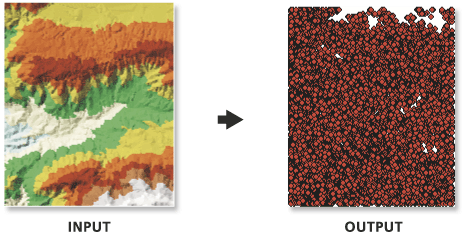Resumen
Exporta los nodos de un dataset de red irregular de triángulos (TIN) a una clase de entidad de puntos.
Ilustración

Uso
Llenar un nombre para el parámetro Campo de punto resulta en la creación de clase de entidad de punto 2D. Omitir el nombre crea puntos 3D.
- Si el TIN tiene valores de etiqueta asignados a sus triángulos, los puntos se pueden atribuir con estos valores al especificar el nombre en el parámetro Campo de valor de etiqueta. Cualquier nodo que no tenga valores de etiqueta asignados explícitamente asumirá un valor de 0.
Sintaxis
TinNode(in_tin, out_feature_class, {spot_field}, {tag_field})| Parámetro | Explicación | Tipo de datos |
in_tin | El dataset de TIN que se va a procesar. | TIN Layer |
out_feature_class | La clase de entidad que generará esta herramienta. | Feature Class |
spot_field (Opcional) | El nombre del campo del atributo de elevación de la clase de entidad de salida. Si se proporciona un nombre, la clase de entidad será 2D; en caso contrario, será 3D. No se proporciona ningún nombre de manera predeterminada, lo que resulta en la creación de entidades de punto 3D. | String |
tag_field (Opcional) | El nombre del campo que almacena el atributo de etiqueta en la clase de entidad de salida. Por defecto, no se crea un campo de valor de etiqueta. | String |
Muestra de código
En el siguiente ejemplo se muestra cómo usar esta herramienta en la ventana de Python.
arcpy.env.workspace = 'C:/data'
arcpy.TinNode_3d('tin', 'elevation_node.shp', spot_field='Elevation')En el siguiente ejemplo se muestra cómo usar esta herramienta en un script independiente de Python.
"""****************************************************************************
Name: Create Terrain from TIN
Description: This script demonstrates how to create a terrain dataset using
features extracted from a TIN. It is particularly useful in
situations where the source data used in the TIN is not available,
and the amount of data stored in the TIN proves to be too large
for the TIN. The terrain's scalability will allow improved
display performance and faster analysis. The script is designed
to work as a script tool with 5 input arguments.
****************************************************************************"""
# Import system modules
import arcpy
# Set local variables
tin = arcpy.GetParameterAsText(0) # TIN used to create terrain
gdbLocation = arcpy.GetParameterAsText(1) # Folder that will store terran GDB
gdbName = arcpy.GetParameterAsText(2) # Name of terrain GDB
fdName = arcpy.GetParameterAsText(3) # Name of feature dataset
terrainName = arcpy.GetParameterAsText(4) # Name of terrain
try:
# Create the file gdb that will store the feature dataset
arcpy.management.CreateFileGDB(gdbLocation, gdbName)
gdb = '{0}/{1}'.format(gdbLocation, gdbName)
# Obtain spatial reference from TIN
SR = arcpy.Describe(tin).spatialReference
# Create the feature dataset that will store the terrain
arcpy.management.CreateFeatureDataset(gdb, fdName, SR)
fd = '{0}/{1}'.format(gdb, fdName)
# Export TIN elements to feature classes for terrain
arcpy.AddMessage("Exporting TIN footprint to define terrain boundary...")
boundary = "{0}/boundary".format(fd)
# Execute TinDomain
arcpy.ddd.TinDomain(tin, tinDomain, 'POLYGON')
arcpy.AddMessage("Exporting TIN breaklines...")
breaklines = "{0}/breaklines".format(fd)
# Execute TinLine
arcpy.ddd.TinLine(tin, breaklines, "Code")
arcpy.AddMessage("Exporting TIN nodes...")
masspoints = "{0}/masspoints".format(fd)
# Execute TinNode
arcpy.ddd.TinNode(sourceTIN, TIN_nodes)
arcpy.AddMessage("Creating terrain dataset...")
terrain = "terrain_from_tin"
# Execute CreateTerrain
arcpy.ddd.CreateTerrain(fd, terrainName, 10, 50000, "",
"WINDOWSIZE", "ZMEAN", "NONE", 1)
arcpy.AddMessage("Adding terrain pyramid levels...")
terrain = "{0}/{1}".format(fd, terrainName)
pyramids = ["20 5000", "25 10000", "35 25000", "50 50000"]
# Execute AddTerrainPyramidLevel
arcpy.ddd.AddTerrainPyramidLevel(terrain, "", pyramids)
arcpy.AddMessage("Adding features to terrain...")
inFeatures = "{0} Shape softclip 1 0 10 true false boundary_embed <None> "\
"false; {1} Shape masspoints 1 0 50 true false points_embed "\
"<None> false; {2} Shape softline 1 0 25 false false lines_embed "\
"<None> false".format(boundary, masspoints, breaklines)
# Execute AddFeatureClassToTerrain
arcpy.ddd.AddFeatureClassToTerrain(terrain, inFeatures)
arcpy.AddMessage("Building terrain...")
# Execute BuildTerrain
arcpy.ddd.BuildTerrain(terrain, "NO_UPDATE_EXTENT")
arcpy.GetMessages()
except arcpy.ExecuteError:
print(arcpy.GetMessages())
except Exception as err:
print(err)Entornos
Información de licenciamiento
- Basic: Requiere 3D Analyst
- Standard: Requiere 3D Analyst
- Advanced: Requiere 3D Analyst